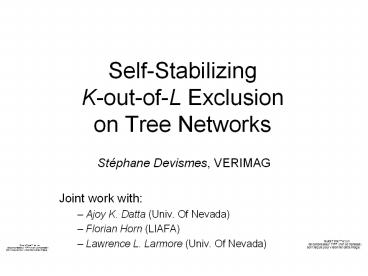Self-Stabilizing%20K-out-of-L%20Exclusion%20on%20Tree%20Networks - PowerPoint PPT Presentation
Title:
Self-Stabilizing%20K-out-of-L%20Exclusion%20on%20Tree%20Networks
Description:
SHAMAN Meeting. 10. Fairness. Each request (of at most K units) is satisfied in finite time ... SHAMAN Meeting. 11. Efficiency ' As many requests as possible ... – PowerPoint PPT presentation
Number of Views:20
Avg rating:3.0/5.0
Title: Self-Stabilizing%20K-out-of-L%20Exclusion%20on%20Tree%20Networks
1
Self-StabilizingK-out-of-L Exclusionon Tree
Networks
- Stéphane Devismes, VERIMAG
- Joint work with
- Ajoy K. Datta (Univ. Of Nevada)
- Florian Horn (LIAFA)
- Lawrence L. Larmore (Univ. Of Nevada)
2
Roadmap
- Recall on Self-stabilization
- Definition of the problem
- The solution
- Conclusion and perspectives
3
Roadmap
- Recall on Self-stabilization
- Definition of the problem
- The solution
- Conclusion and perspectives
4
Self-Stabilization Closure Convergence
Closure
Legitimate States
Illegitimate States
Convergence
States of the System
5
Property Tolerance to Transient Faults
6
Roadmap
- Recall on Self-stabilization
- Definition of the problem
- The solution
- Conclusion and Perspectives
7
K-out-of-L Exclusion Raynal, 91
- L resource units
- Requests from 1 to K resource units (KL)
8
K-out-of-L Exclusion
- 3 property to ensure
- Safety
- Fairness
- Efficiency
9
Safety
- At any time
- Each resource unit is used by at most one process
- Each process uses at most K resource units
- At most L resource units are available
10
Fairness
- Each request (of at most K units) is satisfied in
finite time - (i.e. the process then uses the resource units it
holds in a special section of code called
critical section)
11
Efficiency
- As many requests as possible must be satisfied
simultaneously - More formally (K,L)-Liveness
12
(K,L)-Liveness
2?
3?
1?
13
Waiting Time
- The maximum number of time, all other processes
can enter in the critical section before some
process p, starting from the moment requests the
critical section
14
Roadmap
- Recall on Self-stabilization
- Definition of the problem
- The solution
- Conclusion and perspectives
15
Model
- Message-passing
- Bounded process memories
- FIFO bidirectional links
- Topology oriented tree
- Necessary condition Gouda-Multari, 91
- Bounded link capacity (CMAX)
16
Approach
- Token-based (resource units tokens)
- Modular
- Non Self-stabilizing K-out-of-L Exclusion
- Self-stabilizing Controller
17
DFS circulation
18
First idea K-out-of-L Exclusion L-circulation
0
3?
2
1
0
0,2
0,2,2
ltCSgt
19
Deadlocks
r
0
1
0
3?
2?
0
0,0
1
1
1
2
3
2
0
0
0
0
0
2?
2?
0
0
20
Solution
- Circulation of a special token
- the pusher
- Upon receiving the pusher
- a node releases all its resource tokens
- if its request is not satisfied
21
Livelock
0
1?
0
1
0
0
0
0
1?
2?
22
Solution
- Circulation of a Priority Token
- A requesting process keeps the Priority Token
while its request is unsatisfied - The Priority Token cancels the effect of the
Pusher Token
23
Self-Stabilization The Controller
- After transient faults
- Some tokens may have disappeared
- Some tokens may been duplicated
- Solution a Controller Token counts and regulates
the number of tokens
24
Example Count the Resource Tokens
25
Example Count the Resource Tokens
0
1
2
1
0,1
1
0,1
2
2
0,1
2
26
Example Count the Resource Tokens
- At the end of the traversal
- The number of token is known
- Too much tokens RESET
- Lake of tokens Creation at the root
27
How to stabilize the Controller ?
- Implemented as a Self-Stabilizing DFTC using the
Varghese Counter Flushing
28
Self-Stabilizing DFTC
r
- TokenHolder
- Receive MesVal from a child and MyVal MesVal
- Receive MesVal from Parent and MyVal ? MesVal
0
1
0
0
1
0
0
1
0
0
0
1
0
Stabilize using (n-1)(2CMAX1)1 values
1
0
29
Roadmap
- Recall on Self-stabilization
- Definition of the problem
- The solution
- Conclusion and perspectives
30
Conclusion
- Waiting Time L(2n-3)2
- Oriented Tree -gt Arbitrary Rooted Network
(Huang-Chen BFS Tree) - Bounded/Unbounded Link Capacity
- (Katz Perry)
31
Perspectives
- Compute the convergence time
- Enhance the waiting time ?
- Reactive solution ?
- Fault-Containment ?
32
Thank you!
33
(K,L)-Liveness
- Let V be the set of processes
- Let I be a subset of processes that execute their
critical section forever (in particular they hold
some resource units forever) - Let ? be the number of resource units held by I
- Let R be the subset of V - I such that any
process in R is a requestor - Let rmax by the maximal request of a process in R
- If R ?Ø and rmax L - ? then at least one member
of R eventually satisfies its request































